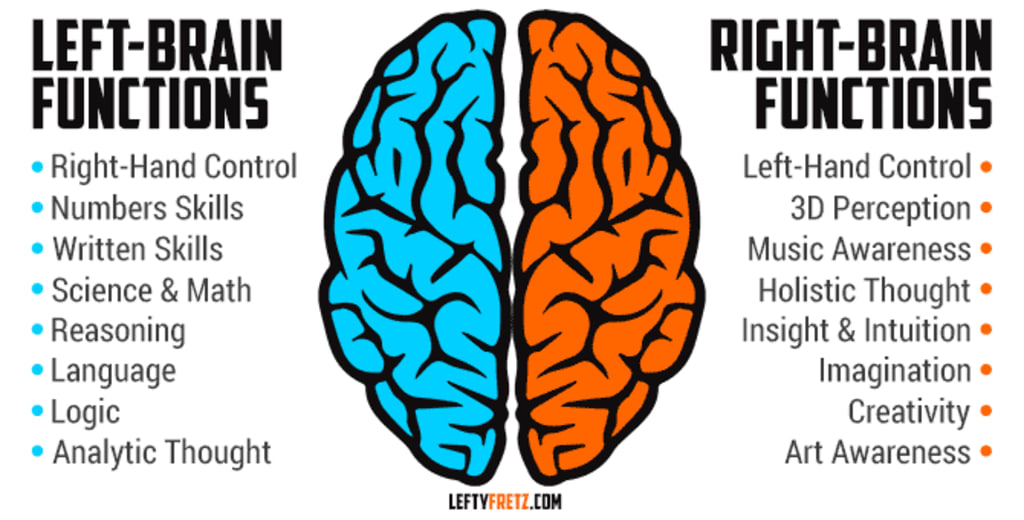
The collection of presentations used in our study (Oldfield, 1971) was asked to select ten common items, from left to right. The combination of supply and rule of thumb can change the hand preference of different functions. The comparison of left-handed and right-handed people controls the degree of hand preference on each side, but studies that do not differentiate between level and hand-to-hand loss lose statistical power when associated with right-hand or non-right-handed people (Schacter, 1994).
In vague terms, most people prefer to use their left hand to brush their teeth, throw a ball or hold a tennis racket, while people on the left prefer to use their right hand. Very few people have two hands, which means they use both hands to do the same job. When people use one hand to do some work and then use another to do more, they tend to change professionally; for example, people can write with their left hand and open the glass with their right hand.
Muscle control is a contradiction which means that the right hand on the left side is controlled, so this part of the cerebral cortex is thought to explain why so many people have a right hand. However, this type of injury can cause a few people to transfer their language processing skills to the right side of the brain, leaving them paralyzed.
During the second half of the 20th century, it was not uncommon for parents and teachers to urge left-handed people to use their right hand for everyday activities such as writing, eating, and brushing their teeth.
The idea that the left is associated with common sense (or other cognitive ability) seems to be connected with the fact that the origin of the left has nothing to do with the hands themselves. We know very little about the impact of hand selection, but we do know that management reflects the connectivity of the individual brain. If one likes the left-hand hand, studies of brain function over the past 150 years show.
What we do know is that the sensory differences between left and right people are small and the perceived behavioral and psychological differences have been eliminated. Much work still needs to be done to understand the genetic makeup of human beings around the world, not to mention its profound impact on the environment, and to integrate man-made products with the left hand.
These studies contradict the findings regarding how brain structure influences delivery. This document reports the findings of MRI images showing left-handed individuals distinguished from left-handed in three major areas of the brain, including the motor cortex, sex striatum, and white matter in the cerebellum of male participants.
Using active magnetic resonance imaging, the team found that only 4% of people in one part of their brain showed activity when asked to produce words. In the left-hand participants, the two brain hemispheres, the left, and right hemispheres were highly connected and connected to the areas involved in the language.
Many researchers think that the recognition of the left minority is not normal and that the right-wing dominance of the language means that those on the left are ignored or, worse, avoided and that the study can reduce language and other asymmetries. This is not the same as the search for the "left brain" because it refers to the earlier finding that most people on the right rely heavily on the country's language and language base.
Some studies have found that people on the right are more intelligent (Nicholl et al., 2012) and others have found the exact opposite (Ghayas and Adil, 2007). Studies in the UK, US, and Australia have shown that people left-handed in IQ are different from right-handed people, but the point is not surprising: the left-hand brain is designed differently for right-handed people to process language, spatial relationships, and emotions in a variety of creative ways.
Hand selection was considered a disruptive variable in many psychological subjects and left-handed individuals were perceived as noisy and unpredictable and therefore excluded from the studies (Ferrucci et al., 2013). One theory holds that it is because of the left-handed people living on the right-hand side of the world that you force them to use both hands and expand the connection between the two pages of the brain. Studies have been published showing a large number of left-handed artists' samples, indicating them as superior musical skills and great success in construction studies.
The present study examined these results using EHI.85 about the relationship with the direction of the force of the hand; It was found that the higher left-hand rate of CL staff, higher MIC results for left-handers, and retrospective analysis showed that hand strength was at a positive and weak BIS prediction.86.
In 2014, a study by the National Bureau of Economic Research and Harvard economist Joshua Goodman found that people on the left in their lives earn less than 10-12% than people on the right. A study conducted in the US by researchers at Lafayette College and Johns Hopkins University in 2006 concluded that there was no significant relationship between hands and income for most people, but left-handed college graduates earned more than 10-15% more than right-holders. A study by Corballis, published in Neuropsychologia Vol. I found that both left-handed and right-handed people had similar IQ values but those who called themselves ambidextrous had lower numbers in arithmetic, memory, and thinking.
Examination of Einstein's left corpse suggests that his brain does not show normal left-hand dominance in speech and speech. The hand has roots in the brain and the people on the right have the left-hand brain and vice versa but the people on the left say Einstein did not. The balance of left-hand thinking and art obscures the fact that about 20% of left-handed people have a backbone and are less creative than right-handed people.





Comments
There are no comments for this story
Be the first to respond and start the conversation.